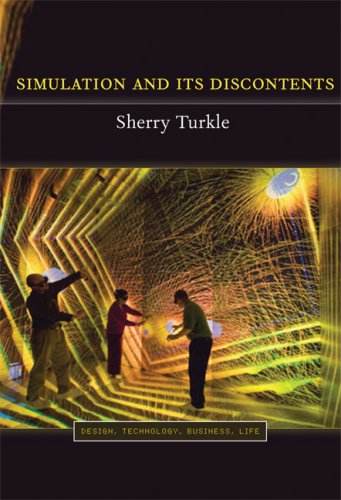Reviewed by
Roy Wilson
Jury Simulation Research, Pittsburgh, USA
 Is this book worth reading? It depends.
Is this book worth reading? It depends.This book is based on prior studies of the impact of simulation on scientific, engineering, and design identities. The intended audience of the book might be indicated by following observation by the editor of the Simplicity: Design, Technology, Business, Life series (of which this book is a volume): 'The concepts in this short historical piece by Turkle trace a clear path from the technology in the laboratory to the living virtual landscape in which we thrive today.' If so, practitioners of social science simulation should not be surprised by the absence of new approaches to: the task of building simulation models; running them; or methods to smooth the sometimes rocky road to interpreting the outputs.
Turkle examines the tension between doing simulation and doubting it. Although students at the Massachusetts Institute of Technology in the 1980s and 2000s were most susceptible to the seductions of simulation-based visualizations, by the millennium professors and professionals alike had been forced/encouraged/seduced to negotiate a new professional identity. In this negotiation, the use or practice of simulation was a major element.
Opacity is the key issue for both early and more contemporary doubters: they want to be able to 'see the code.' The question for the working scientist is, according to Turkle: 'What level and language will provide enough understanding for me to compare the simulation before me with what I know of physical reality?' A related question might be asked by the working computational social scientist.
What can serve as the provider of brute fact that enables us to effectively doubt social system simulation and the simulations we do? The very simulations created by computational social scientists may be playing the roles of mock-apple and mock-gravity in the 'discovery' of social regularities and the social mechanisms that occasion their production. In the absence of empirical data against which to (partially) assess the performance of a model, relevant theories (from sociology or sociological social psychology, for example) may provide a set of regulating expectations (Conte 2009).
Simulation and Its Discontents does not raise the issue of doubting and doing in the context of social system simulation. It does, however, invite the reader to do so. Despite this ascribed virtue, (at least) one substantive shortcoming and several irritating stylistic features can also be ascribed to it.
First, Turkle is perhaps less careful in this book than if a different audience were being addressed. In describing simulation and design in the 1980s Turkle observes: 'These technical troubles [at the field site] obscured the reality that month-by-month, year-by-year, design software was overcoming its doubters.' For those in the know, this phrasing may bring to mind actor-network theory (which accords to inanimate objects a first-class explanatory role in accounting for the evolution of technological systems); for those not in the know, it may simply reinforce the 'bad old' technological determinism that continues to infect practitioners, theorists, and their observers. In this reviewer's opinion, at least one note citing a beginner's text such as Grint and Woolgar (1997) was required by authorial due diligence.
Second, this book combines a somewhat less academic expository style with a somewhat more technical citation style. I found myself ('frequently') flipping to the endnotes for elaboration (or asides) to find only a mere page number of a technical report or a dissertation funded by the United States National Science Foundation that grew out of the research.
Despite the above complaints, I found this book thought-provoking, not unlike a Rorschach ink-blot. Simulation and Its Discontents invites consideration of social system simulation in a somewhat different, less methodological, light (Cederman 2005). Such consideration may help further illuminate the relationship between the practice of social system simulation and the practice of social system theorizing.
CONTE , R (2009) 'From Simulation To theory (and Backward)'. In Flaminio Squazzoni (ed.), Epistemological Aspects of Computer Simulation in the Social Sciences. Berlin: Springer Verlag, 29-47
GRINT, K and WOOLGAR, S (1997) The Machine at Work: Technology, Work, and Organization . Cambridge: Polity Press
Return to Contents
of this issue
© Copyright Journal of Artificial Societies and Social Simulation, 2009